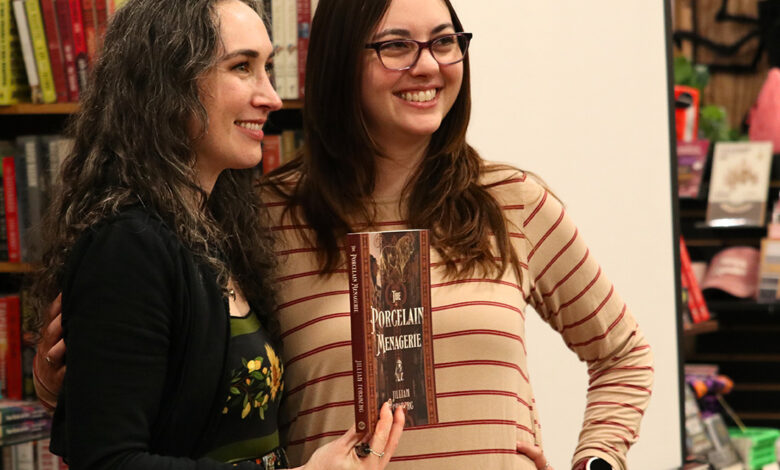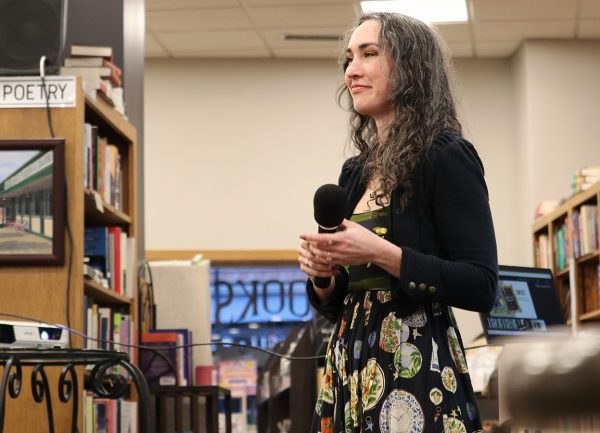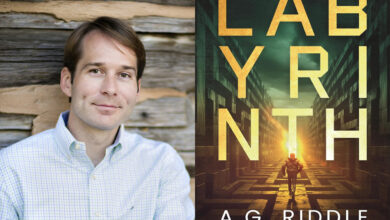Author finds her novel’s muse buried across the street – The Sunflower

While researching her latest historical-fiction novel, Kansas author Jillian Forsberg booked an Airbnb in the German town of Meissen, hoping to trace the footsteps of the characters who inspired her work.
She did not expect to find one of them, featured in her latest novel, “The Porcelain Menagerie,” buried across the street, visible from the flat’s window.
Forsberg earned a master’s degree in public history in 2012 from Wichita State, after getting her bachelor’s degree in communication and history from McPherson in 2010.
She traded her dream job giving museum tours after a few years in her white gloves – for handling fragile artifacts in exhibits – for a career driven by curiosity and creativity, saying, “Once you get curious, you’re always curious.”
By following her curiosity and passions, Forsberg found herself with her husband in Germany.
“My Airbnb was just this tiny flat in Meissen, and the window looked right out onto a little cemetery,” Forsberg said. “I didn’t realize until later that it was the cemetery where Kändler was buried.”
Johann Kändler was an 18th-century sculptor for King Augustus, king of Poland and Elector of Saxony, who helped transform porcelain into Europe’s most prized art form. His life and craft form the core of Forsberg’s new novel, “The Porcelain Menagerie,” which debuted Oct. 21, and which she discussed the following Thursday at Watermark Books & Cafe in an official book launch. Her books weave dual timelines and several points of view.
“It was one of those moments that made me realize how close the past actually is – like all these people I’ve been writing about are still right here,” she said. “It was eerie and comforting at the same time. I just stood there for a long time and cried.”
The writer builds her stories around real historical animals, moments and the people connected to them. “The Porcelain Menagerie” features various exotic animals, while her first novel, “The Rhino Keeper,” focuses on an Indian rhinoceros named Clara that toured Europe in the 1740s with a Dutch captain.
“Just because they can’t speak doesn’t mean they don’t have something to say,” Forsberg said. “Animals connect people – no matter where you’re from, who you love or what part of the political spectrum you’re on.”
Her new novel steps beyond the animal world into the lives of those surrounding a king obsessed with “white gold,” as porcelain was once known. Animals, such as a tortoise, are essential to the book’s central plot.
“Drama, intrigue, danger, obsession, apprehension – basically, this book is full of ‘I’m not sure what’s going to happen in my life and I might not survive this’ kind of vibes,” Forsberg said.
Writing “The Porcelain Menagerie” required months of research in archives and museums – as well as a person to help translate historical documents.
“A lot of the sources were in German, so it was really hard,” Forsberg said. “You’re reading 18th-century writing, translating it from German to English, and it’s written in really specific cursive or script. That was a huge challenge.”
Forsberg’s publisher, Colin Mustful, said the writer’s attention to historical detail stood out to him immediately. “I met her at the Historical Novel Society of North America,” Mustful said. “She told me about her book, and I thought, that sounds really interesting –like obscure, well-researched history. When she submitted it, it was really good, and I didn’t have to think about it much before saying ‘yes.’”
The publishing company, History Through Fiction, was founded by Mustful in 2019 and he has since dedicated twice the hours of a typical 9-5 job. As a small-press publisher, he supports authors by being physically present as much as he can.
“I can’t give authors the same resources as a big publisher – so instead, I just show up,” he said. “I go to their events, support them however I can. That’s really important to me.”
Mustful traveled from his home in Minneapolis to attend the official launch of Forsberg’s “The Porcelain Menagerie.”

The event held a mini history lesson, a Q&A and an unexpected but audience-requested live reading.
At Watermark, Forsberg emphasized the importance of supporting local talent – wherever that talent is.
“Local bookstores and local writers are valuable. Truly,” Forsberg said. “I think often people hear the words ‘local writer’ or ‘local bookstore’ and they think, oh, you know, ‘mediocre.’ But there’s a lot of talent in Kansas.”
She said her success started to feel real after a small moment at home with her first book, “The Rhino Keeper.”
“My husband came home one day and said, ‘I just went to a house where your book was sitting on their coffee table.’ That’s when it hit me.” Her husband, Cody, is a nurse practitioner who takes house calls.
Her second book has been published after months of hard work. Forsberg researched, traveled and cried throughout the process of creating this work.
Standing before Kändler’s grave, Forsberg said she felt the weight of history.
“When I found his grave, I just started crying,” Forsberg said. “I had spent so much time with him in research and in writing that seeing his name carved in stone felt like seeing an old friend.”
Source link




